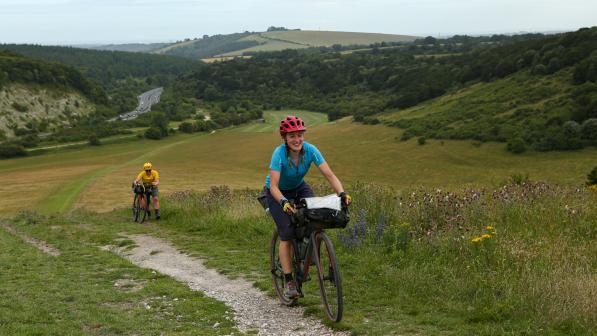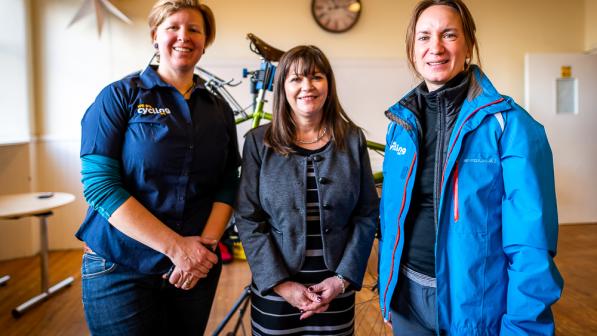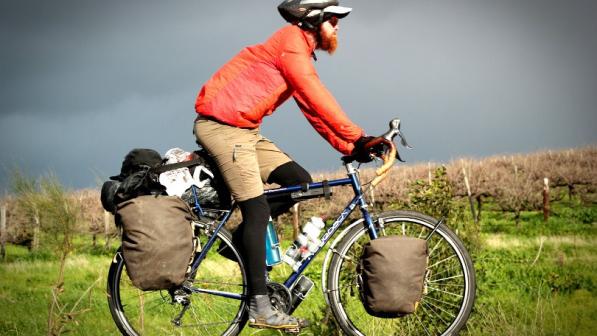Seasonal Affective Disorder and cycling

It’s that time of the year when animals begin hibernating for the colder months, with many of us also wishing we could tuck ourselves away somewhere cosy until the warmth of spring comes back around. It’s not uncommon to feel more lethargic than usual as the temperature outside drops. Suddenly, going for a bike ride seems more demanding, and maintaining a healthy and happy mind can seem more challenging too. You’re not alone in feeling a little sluggish and lower in mood than usual, it’s a mental health condition called SAD.
As the clocks go back an hour each autumn and the Earth tilts further away from the sun, we lose valuable hours of sunlight throughout the winter months. The sun enables us to produce nourishing Vitamin D which is responsible for a myriad of healthy advantages including healthy bones, absorption of calcium by the body and regulating our mood to help ward off depression. During the colder months of the year, we’re exposed to less sunlight, which results in a decrease of Vitamin D production.
It’s because of this that approximately one-third of the UK’s population suffer from Seasonal Affective Disorder (SAD).
What is SAD?
If you’ve ever woken up on a chilly dark morning in the winter with a distinct lack of energy or enthusiasm to do very much, you may be suffering from SAD. Even if there’s nothing particularly negative in your life, Seasonal Affective Disorder can often leave you feeling a little lacklustre, and sometimes, well, sad.
Seasonal Affective Disorder is a medical term for low-moods that have developed due to the change in seasons. GP, cyclist, Cycle magazine's health expert and healthcare professional, Dr Kate Hattersley explains what SAD actually is; “Seasonal Affective Disorder is a mental health condition which is common and disabling. The mechanisms producing SAD are thought to be low light conditions causing low serotonin levels, a compound which is a feel-good chemical. There may also be an element of Vitamin D deficiency which can produce a low mood.”
Seasonal Affective Disorder is a mental health condition which is common and disabling.
Dr Kate Hattersley GP partner at Topsham Surgery
Symptoms of SAD
While there are many common symptoms that can arise from SAD, people can experience different and varying traits. “The term ‘affective’ means a disturbance of mood. In this case, a persistent lowering of mood which can be associated with lethargy, excessive sleeping and craving of carbohydrate comfort foods. Feelings of irritability, low self-worth and guilt are common also,” explains Dr Hattersley.
For some people, like mountain biker, Nikki Eve, SAD can make her day-to-day living just that little bit more difficult as Nikki describes, “It's like having a weighted suit on and a negative cloud making thinking harder and concentration a battle.” Whereas cycling photographer, Saskia Dugon finds that getting out of bed can be a struggle in itself; “I’ll often spend hours in bed. Sometimes I’ll bring my laptop into bed (which is NOT a good thing) or spend my time working or scrolling on my phone, or on really bad days, I’ll just stare at the ceiling having an internal debate about how I really really should get up.”
In addition to feeling physically lethargic, SAD can manifest itself in the form of depression, feeling hopeless and wanting to withdraw from others. All these negative thoughts and feelings lend hand to feeling unmotivated to engage in physical activity and preferring to eat your way to comfort. However daunting and debilitating these symptoms may sound, there are a few things you can do to help alleviate the effects of SAD.
Tips for combating SAD
As Dr Hattersley explained, SAD is linked to a reduction in our happy-chemical, Serotonin. We can help boost serotonin production by making a few small adjustments to our lifestyle, with one of the biggest tools for fending off SAD, exercise. “Getting outside and exercising regularly is protective against poor mental health and it’s a good treatment for those diagnosed with SAD. We almost all benefit from the healthy glow and endorphin boost we get in after an energetic bike ride or a walk in the woods. Riding in company with a club or group would also give the benefit of social interaction and learning safe local cycle routes to avoid traffic,” recommends Dr Hattersely.
Getting out for a bike ride certainly helps mountain biker, Nikki, “Cycling helps so much because, in truth, it's one of the only times I feel like I can push through and get that energetic boost. The adrenaline and drive to get up the hill, only to bomb back down is like no other, and investing in decent lights so I can cycle after work in the dark is honestly what is holding my sanity together.” For Saskia, cycling isn’t the only thing to see her through the colder and darker months, “One thing that has helped me try and embrace the darker months is outdoor swimming. The shock of the cold water is great training for keeping my mind calm and on track when under pressure.”
Other treatments to help combat SAD include using a daylight lamp to increase light exposure. A daylight lamp (or light therapy lamp) has a brightness of at least 2,500 lux and helps to suppress your natural release of melatonin, the sleepy-chemical. Although artificial light, these lamps may not cure SAD however, they can improve your mood and energy levels within a few days of use. It’s also recommended to reduce your intake of alcohol, which may be tricky when the festive period is in full swing, but alcohol can contribute to a lower mood, irritability and feeling groggy the next day!
Seasonal Affective Disorder is a mental health condition where talking-therapy can help you identify your moods and feelings, and provide you with the tools to work through them. Often coupled with counselling are anti-depressant medication with Selective Serotonin Reuptake Inhibitors (SSRIs) which help promote serotonin production. For more information about counselling and medication, consult your GP or healthcare professional.
The NHS website provides further information on what Seasonal Affective Disorder is and how you can combat its effects. Other useful online resources include Mind and your local healthcare centre. If you would prefer to speak with someone on the phone, call NHS 111.





